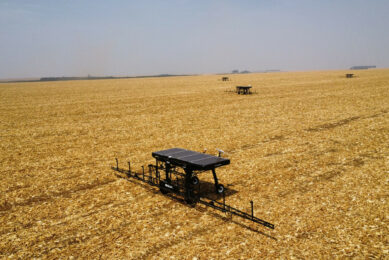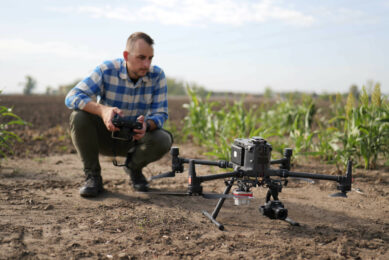Sowing cover crops in maize with a drone

Pieter van Leeuwen Boomkamp in Nijkerk, the Netherlands, anticipating the harvest in mid-September, had the cover crop sown in his silage maize using a drone. The idea behind this is that it might allow him to postpone the chopping until after October 1st. Following Dutch law you have to sow a cover crop before October 1st. By that time, the cover crop, a mixture of leaf radish and leaf cabbage, will already be sown and germinated.
Underseeding has been done earlier in the season on the other fields at Van Leeuwen Boomkamp using the proven method with an underseeding hoe. At that time, the maize was about knee-high. However, this timing interferes with weed control. With this late sowing, the grower gains more flexibility in weed control, especially for addressing grasses. This advantage is even more pronounced when compared to sowing grass simultaneously with maize planting.
An additional disadvantage of sowing grass as an underseed, as Van Leeuwen Boomkamp has experienced, is the risk of grass overpowering the maize. Moreover, grasses (such as rye grass) are not well-suited for crop rotation due to nematode proliferation, even with later sowing. Also, because the company largely practices non-tillage farming, established grass can be challenging to destroy in order to plant. Hence, the experiment with the drone. In short, the seed mixture is spread in a precise pattern by a centrifugal spreader beneath the drone’s seed hopper.
Text continues below picture

Research questions
The research questions are:
- whether enough seed actually lands on the ground and doesn’t remain too much in the maize plant axils;
- whether the seed on the ground germinates and roots adequately;
- to what extent the newly emerged cover crop is damaged by the passage of the harvesting train.
Experts from Wageningen University & Research (WUR) are assessing these two maize fields in Nijkerk in these regards. As for the first point, it appears that enough seed is indeed reaching the ground. Somewhat unexpectedly, little to no seed remains in the leaf axils of the maize plant.
What has helped with both points 1 and 2 is that 70 mm of rain fell a few days after sowing. Van Leeuwen Boomkamp says, “At the moment, it looks good; the rain has also done well here.” Of course, this could be compensated by sowing more cover crop. There are no figures available yet.
Text continues below picture

Coating of clay and compost
To encourage the germination and establishment of the cover crop, the leaf cabbage and leaf radish seeds have been treated. They are coated with a mixture of clay and compost. This coating absorbs moisture and helps the germinating seed through any dry spells. Moist soil and/or some rain shortly after sowing are beneficial, but a period of drought after sowing is not a problem in itself.
As mentioned, this is the concept. Whether it actually works out will be determined by the experiment at Van Leeuwen Boomkamp. Arjan Jansma from the innovation company Qlobel, which leads this experiment, is not concerned. He is relying on a previous experiment with this underseeding-with-drone technique in Zeeland in July. “That went well. The maize was one meter high at sowing.”
Text continues below picture

Costs of sowing with the drone
As for the cost of sowing with the drone, for this application, one should consider an amount in the range of € 90 to € 110 per hectare. This includes the coating but excludes the seed. Jansma says, “It depends on specific conditions, the amount of seed you want to sow, the area, and the size of the drone.”
Van Leeuwen Boomkamp sowed over 20 kilograms of seed per hectare. The drone carried 2 kilograms of seed per flight. 6 kilograms could have been carried in terms of weight, but due to the coating, the seed’s specific weight was so low that the seed hopper was already filled with just 2 kilograms. WUR and the National Fieldlab for Precision Farming (NPPL) are monitoring the development of the cover crop in Nijkerk. WUR researcher Jos Tielen says, “We will look at it just before and right after chopping and then again after a few weeks.”
Join 17,000+ subscribers
Subscribe to our newsletter to stay updated about all the need-to-know content in the agricultural sector, two times a week.



